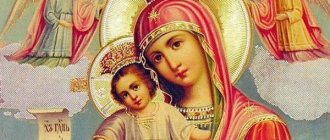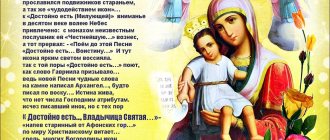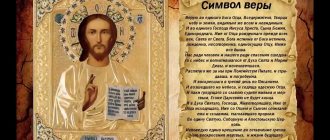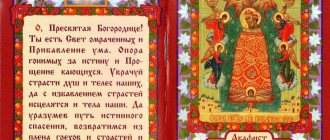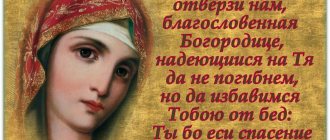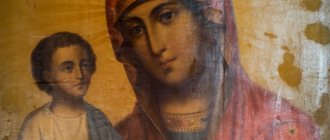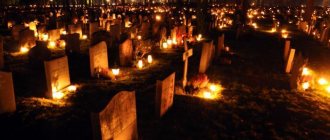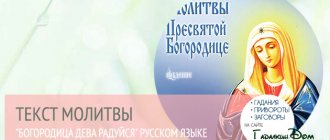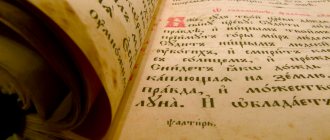"All creation" redirects here. For the song MercyMe, see All Creations (song).
Russian icon of the Mother of God,
Worthy of Dať
(
Aksion Estin
), 19th century.
Axion estin
(Greek: Ἄξιον ἐστίν, Slavic: It is worthy to eat,
It is worthy to yesť
), or
This is really a meeting
, this is the megalinarion and the Mother of God, i.e.
increase[1] from and the Hymn to Mary is used in Divine Services from the Eastern Orthodox and Byzantine Catholic churches. It consists of a troparion and sticheron composed in honor of the Theotokos (ie the Virgin Mary). Axion estin
is also the name of the icon from the Virgin Mary as well as the style of icons modeled after it.
Hymn
Text
Hymn in Greek:
Ἄξιόν ἐστιν ὡς ἀληθῶς, μακαρίζειν σε τὴν Θεοτόκον, τὴν ἀειμακάρι στον καὶ παναμώμητον καὶ μητέρα τοῦ Θεοῦ ἡμῶν. ? φείμ, τὴν ἀδιαφθόρως Θεὸν Λόγον τεκοῦσαν, τὴν ὄντως Θεοτόκον, σὲ με γαλύνομεν.
One translation of the hymn goes like this:
It is right to bless You, Mother of God, You are eternally blessed and pure and the Mother of our God. You are more noble than the cherubim, and beyond all comparison more glorious than the seraphim, who without corruption gave birth to God the Word, You, true Mother of God, we exalt You.
Story
The second half of the hymn, beginning with the words: "Nobler than the cherubim...", is the older part of the hymn and is Irmos attributed to Saint Cosmas the hymnographer († 773). The preface “This is truly worthy...” was, according to tradition, revealed by Archangel Gabriel to the monk on Mount Athos.
Liturgical use
The hymn is sung at Matins, Companion, and other services; but its most important manifestation is the Divine Liturgy, where it is sung at the end of the Anaphora. The second half of the hymn "More Noble..." is often sung before the dismissal which ends the service.
Often the singing of this hymn is followed by either throwing or prostration.
Hymns instead of Aksion Estin
Icon of the Mother of God “All creation rejoices in You.”
During the Divine Liturgy, Aksion Estin
sometimes replaced by another hymn to the Virgin Mary.
These hymns are referred to in the service books as "instead of Aksion Estin
" (Slavic: Zadostoinnik,
Zadostoinnik
), or by the term "eis to Exairetos", meaning "in a special (petition)", from the preceding petition calling "specially" for the intercession of the Mother of God.
At the Liturgy of St. St. Basil's, from the 14th century[2] replaced by the hymn:
In Greek:
Πὶ σοὶ χαίρει, Κεχαριτωμένη, πᾶσα ἡ κτίσις. Ἀγγέλων τὸ σύστημα καὶ ἀνθρώπων τὸ γένος, ἡγιασμένε ναὲ καὶ παράδε ?? εν, ὁ πρὸ αἰώνων ὑπάρχων Θεὸς ἡμῶν · τὴν γὰρ σὴν μήτραν θρόνον ἐπο ίησε, καὶ τὴν σὴν γαστέρα πλατυτέραν οὐρανῶν ἀπειργάσατο. Πὶ σοὶ χαίρει, Κεχαριτωμένη, πᾶσα ἡ κτίσις δόξα σοι.
Their translation:
All creation rejoices in you, filled with grace: angels in heaven and humanity, O consecrated temple and spiritual paradise, glory of the virgins, from whom God became incarnate and became a child, our God before the ages. He has turned your body into a throne, and your womb is more spacious than the heavens. All creation rejoices in you, filled with grace: Glory to you.
On the High Holidays, it is replaced by Irmos as the ninth Ode from the Canon of the holiday.
During Easter ( Pentecost
)
Axion estin
is replaced in Anaphora by
the Angel cried
- hymn:
In Greek:
Ὁ῎Αγγελος ἐβόα τῇ Κεχαριτωμένῃ · ῾Αγνή, Παρθένε χαῖρε, καί πάλιν ἐρ ῶ χαῖρε, ὁ σ Υἱός ἀνέστη, τριήμερος ἐκ τάφου.
Φωτίζου, φωτίζου, νέα Ἱερουσαλήμ, ἡ γὰρ δόξα Κυρίου ἐπὶ σὲ ἀνέτειλ ε, Χόρευε νῦν, καὶ ἀγάλλου Σιών, σὺ δὲ ἁγνή, τέρπου Θεοτόκε, ἐν τῇ ἐγέρσει τοῦ τόκου σου.
Translation:
The angel called to the Lady of Grace: Rejoice, pure Virgin! I say again: rejoice! Your Son has risen from three days in the tomb! He raised all the dead with himself! Rejoice, all people!
Shine! Shine! O New Jerusalem! The glory of the Lord has shone upon you! Be exalted and rejoice, O Zion! Shine, Most Holy Theotokos, in the Resurrection of your Son!
Icon of the Mother of God Merciful, forgiving mortal sins
It is believed that the first “Merciful” Icon, the significance of which is enormous for all Orthodox Christians, was painted by Saint Luke. It is this image that is still in the Kykkos monastery on the island of Cyprus.
Before getting to this place, the miraculous icon wandered for a long time. At first she was in Egypt in the temple of one of the Christian communities. In 980, the icon was transported to Constantinople, where it remained until the beginning of the 11th century, and then was brought to Cyprus, where it is kept to this day.
This happened after a very interesting story. So, one day the ruler of Cyprus, Manuel Vutomit, got lost in the forest and beat the monk Isaiah who met him there. For such a sin, Manuel suffered punishment in the form of a serious illness. Meanwhile, Elder Isaiah had a vision that the icon of the Most Holy Theotokos, painted by Saint Luke, would be kept in a temple in Cyprus. After this, the elder, who served the cause of God all his life, began to build a temple and ordered the repentant Manuel to go to Constantinople for forgiveness of his sins and bring the miraculous icon from there. When the Cypriot ruler arrived in Constantinople, he learned that the emperor’s daughter was seriously ill. Manuel promised that the weakening of the disease would occur only after the emperor gave him the icon of the Most Holy Theotokos. And this really happened after the icon arrived at the temple, which by that time had been built by Elder Isaiah.
The prayer of the Most Holy Theotokos, with which the origin of the prayer “It is worthy to eat” is connected, continues to be found on Mount Athos today. The icon depicts the Mother of God and her son - little Jesus Christ, who clings to her. In the hands of the Son of God is prayer.
It is noteworthy that the Face of the Most Holy Theotokos and the Child are covered with a veil. Nobody dares to open it slightly. To remind you that this action is punishable, the monks attached an iron brush to the frame of the icon. This is due to the case when one of the pagans approached a Christian shrine and intended to hit the holy image. But he did not have time to do this, as his hand withered.
The very name of the miraculous icon “Merciful” is due to the fact that believers believe that everyone who turns to the Most Holy Theotokos will receive protection and the necessary help.
Traveling around the world
The icon, which is kept in the temple on Mount Athos, left this holy place only four times. And miracles have always been associated with her, which confirms her great power. Over time, copies of the icon spread to churches all over the world. In Rus', lists of the miraculous icon began to appear in the 16th century.
So, in the Trinity-Sergius Lavra in 1999, the icon “Compassionate” appeared, painted by icon painters of the Holy Mountains. This is a copy of the original image consecrated on Mount Athos. Another list can be found in St. Petersburg, in a five-domed church built in honor of the Virgin Mary. The Svyatogorsk masters also painted an icon of the Most Holy Theotokos for the Iverskaya Chapel in Moscow.
The rite of panagia
This prayer is an integral element of the rite of panagia. The word panagia, which from Greek means All-Holy, was used by Christians in ancient times to call the Mother of God. In the rite performed, which can be held in the church on any day, the words are used in relation to the Mother of God prosphora, because it is she who symbolizes the Queen of Heaven.
This solemn rite consists of bringing prosphora in a special vessel called panagiaro to the monastery meal from the church in which the liturgy was celebrated. The prosphora is broken up and distributed to the brethren at the end of the meal. The rite of panangia is the glorification of the Most Holy Theotokos as the Intercessor of the human race.
She, the Holy Mother of God, who gave birth to God's Son - Jesus Christ, always hears us and is ready to pray for us before God. It is believed that the Bread of Life after the liturgy nourishes our souls. Moreover, in the 16th and 17th centuries there was a tradition of eating the Bread of the Mother of God even on those days when the liturgy was not held. Believers wore particles of the Mother of God bread they received on their chests in special folding bags on which the image of the Mother of God was painted.
Icon and origin
Axion Estin
it is also the name given to the icon of the Theotokos (Mother of God) before which, according to tradition, the hymn was revealed. It stands on the high place of the altar (sanctuary) of the katholikon (main church) of Karies on Mount Athos.
According to tradition, the Elder and his disciple lived in a cell [2] on Mount Athos. One Saturday evening the Elder went to the All-Night Vigil in Karyes. He told his disciple to repeat the service alone. In the evening, an unknown monk came to the cell, calling himself Gabriel, and they began a vigil together. During the ninth Ode of the Canon, when they began to chant the Magnificat, the student sang the original hymn, “More honorable than the cherubim...”, and then the visiting monk sang it again, but with “Worthy indeed...” before the original Irmos. While he was singing, the icon began to glow with the Uncreated Light. When a disciple asked a visiting monk to write down the words of a new hymn, he took a tile and wrote on it with his finger, as if the tile were made of wax. Then the student realized that this was not an ordinary monk, but Archangel Gabriel. At that moment, the Archangel disappeared, but the icon of the Mother of God continued to emit light for some time.
In Eleusa
("Merciful") Icon of the Mother of God, in front of which the hymn "Truly a Meeting" was sung for the first time, was moved to the town of
the Catholicon
(main church) in Karyes, known as
Protaton
. The slab with the hymn written on it was taken to Constantinople when St. Nicholas II Chrysoberges was Patriarch (984-996).
Since then, the icon has been considered the protector of the Holy Mountain and its holiest object.
The meaning of the icon in Orthodoxy
The icon “It is Worthy to Eat” is also called “The Merciful”.
It was written in the 10th century in the cell of the Apostle Andrew the First-Called on Holy Athos. It depicts the Mother of God with the baby Jesus, who holds a scroll in his right hand. The original of the holy image is kept in the central temple of Athonite monasticism. The prototype and its lists are among the most revered images of the Blessed Virgin Mary. The Blessed Virgin is the first petitioner and defender before the Son of God for human sins. The celebration of the icon is June 24. A legend is associated with the holy face about the appearance of the prayer “It is worthy to eat,” which is read in front of this icon.
Text of the prayer “It is worthy to eat”
The prayer to the Blessed Virgin Mary is considered miraculous. First of all, its power is aimed at physical and mental healing. In addition, prayer is effective in any undertaking. A sincere believer before starting any business, turning to the Mother of God with this prayer, can count on success.
The prayer to the Most Holy Theotokos “It is worthy to eat” has more than once saved people from global disasters and epidemics. Often people resort to this prayer to find family happiness and peace of mind. If a person has sincerely repented of his sins, even the most terrible ones, then he can pray for God to forgive his sins by turning this prayer to the Most Holy Theotokos.
Numerous real facts indicate that when people pray at the “Merciful” icon of the Mother of God, they can receive a variety of benefits. For example, such a prayer is often asked to send rain during a drought. Prayer gives a person strength and helps fight the most serious illnesses; infertile couples can ask the Mother of God with such a prayer request for the birth of a child.
Original text in Greek
Listen to the online prayer to the Mother of God in the original:
Download in MP3:
Dostoino-est-na-grecheskom.mp3 [1.65 Mb] (downloads: 44)
Transcription of the prayer with emphasis:
Where is the plate with the holy scripture located and stored?
According to legend, a stone slab with the prayer “It is worthy to eat” inscribed on it was first presented to the council of elders of the Kireysky monastery. Then the artifact in the form of proof was sent to the Ecumenical Patriarch in Constantinople. But, unfortunately, the stone slab has not survived to this day and it is unlikely that traces of it will be found.
Text of the prayer with translation into Russian
In Russian, this prayer sounds like this:
“It is worthy and true for every believer to glorify and praise You, Most Holy Theotokos, You are eternally happy and Most Holy, Who gave birth to our God. And we glorify You with prayer, the real Holy Mother of God, the Most Righteous and Honest of the Cherubim and the most glorious of the Seraphim, who is destined to give birth to the Son of God without breaking virginity.”
Text of the prayer in Church Slavonic
Listen to the audio prayer “It is worthy to eat”:
Download in MP3:
Dostoino-est.mp3 [4.59 Mb] (downloads: 35)
The prayer in Old Church Slavonic goes like this:
It is important to read such a prayer with correctly placed accents. And we also need to remember that prayer will only help sincerely believing people.
Author of the article:
Natalya Nadezhdina
